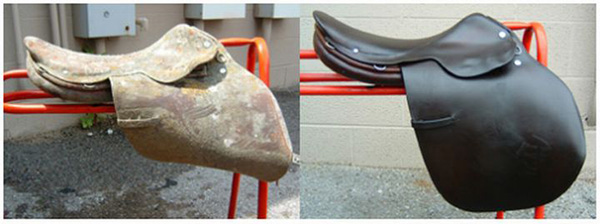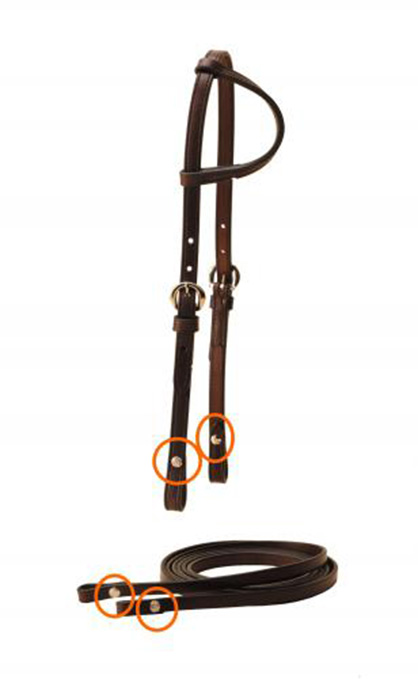Quarantine Hack- Top 5 Tips to Maximize the Life of Your Tack

While you’re in quarantine, there has never been a better time to make sure your tack is clean and in great shape so you will be ready for the next horse show!
By: Taylor Fabus, MSU Extension
In order to maximize the useful life of your horse tack and equipment, you must properly maintain it. Tack and equipment costs can have a huge impact on your entire horse budget. Tack that is properly cared for not only lasts longer, but it can also prevent accidents and injury to both horse and rider due to broken equipment. Read on to discover five simple tips from Michigan State University Extension to maximize the life of your tack and equipment.
Clean up your tack room
A crucial component of clean tack and equipment is your tack room. A clean, cool, and relatively dry room is ideal for maintaining the condition of your tack, especially leather. If your storage area is too humid, it can create an environment where mold can easily grow. Preventing this moist environment may require extra attention during humid summer months.
Furthermore, it’s a good idea to scan your entire tack room on a weekly basis for excessive build-up of dust on rarely used tack, mold growth, or even pet or vermin droppings. Making this scan a weekly process will make it a quick job each time. You’ll have little mess build up in a week’s time, so clean up won’t take long either. However, if you only do a clean up of your tack room on a yearly basis, you’ll find the mess will be much larger and cleanup time much longer. In addition, some messes (especially animal droppings) may have caused permanent damage to your tack if left unattended for too long.
 Tighten up!
Tighten up!
This is a simple yet oh-so important step. Set a schedule, say the 15th of each month, to go through your equipment to be sure connections (like Chicago screws) are secure. In the photo to the left, you can see the common areas, circled in orange, where Chicago screws are located. Ideally, each time you saddle up, you’ll want to give screws a quick check to be sure everything is tight and ready to ride. I’ve also learned it’s best to keep a few sets of Chicago screws on hand in your tack room at all times to replace any that are missing.
Sanitize between horses
It’s commonplace at some boarding and training facilities to share grooming supplies between horses. While this can work well, it’s important to limit the number of germs that are also shared. Keeping a can of disinfectant spray, such as Lysol, handy can be a quick and easy way to limit germs on brushes. Just a quick spray on all of the grooming supplies between each use can kill bacteria, fungi, viruses, mold, and mildew.
Another, and more ideal, option is to have separate brushes and saddle pads for each horse. Be sure to label the equipment with the horse’s name clearly so it doesn’t get shared. Disinfecting brushes periodically is a good practice, even on equipment that isn’t shared. Keep in mind that dirty brushes can’t achieve a clean horse.
Condition your leather
It pains me to see so many “thirsty” saddles being used at horse shows, so much so that I’ve been known to give my friends’ saddles a little conditioning before show time. Although I’ve used many great products over the years, my personal favorite is a one-step cleaner and conditioner. If everything I need is in one bottle, I’m less likely to misplace it and let’s face it, one step is easier!
No matter the product you use, it’s important to condition your saddle at home first to be sure you like how your newly conditioned saddle feels when you ride in it. Some conditioners can leave the saddle sticky and may even cause residue to come off while riding (so be careful if you have a light-colored riding outfit). Personally, in my Hunt Seat Equitation class, I’m comfortable with a little extra saddle grip, but you may find the new feel to be uncomfortable so be sure to test out your new conditioning products at home first.
Deep cleaning
Periodically, say maybe twice a year, it is beneficial to give your equipment a deep cleaning. Wash all horse blankets, saddle pads, polo wraps, and grooming supplies, regardless of if they’ve been recently used. Once your deep cleaning is complete, be sure your storage methods help keep things clean. I store all of my clean, dry blankets and sheets in large plastic containers when they’re not being used. Be sure your containers are marked with their contents, which will make finding what you need much easier. If you find you’re consistently not using certain equipment, think about selling or donating those items after cleaning.
This article was published by Michigan State University Extension. For more information, visit https://extension.msu.edu. To have a digest of information delivered straight to your email inbox, visit https://extension.msu.edu/newsletters. To contact an expert in your area, visit https://extension.msu.edu/experts, or call 888-MSUE4MI (888-678-3464).










